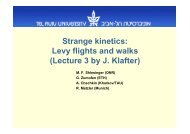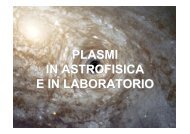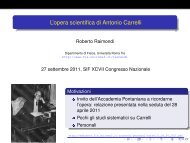De_Angelis_Alessandro.pdf
De_Angelis_Alessandro.pdf
De_Angelis_Alessandro.pdf
Create successful ePaper yourself
Turn your PDF publications into a flip-book with our unique Google optimized e-Paper software.
•<br />
•<br />
•<br />
<br />
<br />
<br />
1
Cluster of very bright stars, Omega Centauri,<br />
as observed from the space:<br />
60,000 K<br />
<br />
<br />
<br />
<br />
2
• <br />
– <br />
<br />
• <br />
– <br />
– <br />
• <br />
– μ<br />
μ<br />
<br />
<br />
• <br />
–
Accretion Disk 3- 10 r s Black Hole Diameter = 2r s ~ 4 AU<br />
~ parsecs<br />
4
hadronic cascades<br />
p + (>>TeV)<br />
matter<br />
0<br />
- +<br />
(TeV)<br />
In the VHE region,<br />
dN/dE ~ E - (: spectral index)<br />
To distinguish between had/leptonic origin<br />
study Spectral Energy Distribution (SED):<br />
(differential flux) . E 2<br />
e.m. processes<br />
e - (TeV)<br />
E 2 dN/dE<br />
B<br />
(eV)<br />
Synchrotron<br />
(eV-keV)<br />
(TeV)<br />
Inverse Compton<br />
0 decay<br />
energy E<br />
VHE<br />
5
• <br />
– <br />
– <br />
<br />
– <br />
– <br />
<br />
• <br />
– <br />
• <br />
– <br />
<br />
– <br />
•
edshift z<br />
30 GeV<br />
100 GeV<br />
> 1<br />
region of opacity<br />
= 1 (GRH)<br />
<strong>De</strong> <strong>Angelis</strong>, Galanti, Roncadelli 2011<br />
with Franceschini EBL modeling<br />
ray energy (TeV)<br />
() ~<br />
<br />
<br />
<br />
VHE bck e + e -<br />
<br />
<br />
<br />
<br />
7
• <br />
–<br />
• <br />
<br />
• <br />
<br />
<br />
<br />
e + e -<br />
9
c ~ 1º<br />
e Threshold @<br />
sl: 21 MeV<br />
Maximum of a 1 TeV<br />
shower<br />
~ 8 Km asl<br />
~ 200 photons/m 2 in<br />
the visible<br />
Angular spread ~ 0.5º<br />
Incoming<br />
-ray<br />
~ 120 m<br />
~ 1 o<br />
The Cherenkov technique<br />
~ 10 km<br />
Image intensity<br />
Shower energy<br />
Image orientation<br />
Shower direction<br />
Image shape<br />
Primary particle 10
c ~ 1º<br />
e Threshold @<br />
sl: 21 MeV<br />
Maximum of a 1 TeV<br />
shower<br />
~ 8 Km asl<br />
~ 200 photons/m 2 in<br />
the visible<br />
Angular spread ~ 0.5º<br />
Incoming<br />
-ray<br />
~ 120 m<br />
~ 1 o<br />
The Cherenkov technique<br />
~ 10 km<br />
Image intensity<br />
Shower energy<br />
Image orientation<br />
Shower direction<br />
Image shape<br />
Primary particle 10
VERITAS: 4 telescopes (~12m) in Arizona operational since 2006<br />
VERITAS: 4 telescopes (~12m) in Arizona operational since 2006<br />
<br />
<br />
Major upgrade expected ~end 2011:<br />
Very large (28m) central telescope in construction<br />
13
• <br />
<br />
<br />
<br />
<br />
<br />
<br />
– <br />
<br />
• <br />
<br />
<br />
• <br />
<br />
14
•<br />
<br />
<br />
•<br />
<br />
<br />
<br />
<br />
•
• <br />
<br />
<br />
<br />
<br />
• <br />
<br />
<br />
<br />
Fermi,<br />
Egret<br />
Magic,<br />
Veritas<br />
<strong>Alessandro</strong> <strong>De</strong> <strong>Angelis</strong><br />
16
W51: gamma rays come from a<br />
molecular cloud separated from the<br />
pulsar<br />
[Albert et al. ApJ RX J1713.7-3946<br />
664L 87A 2007
x<br />
<br />
x<br />
x<br />
() ~<br />
Heitler 1960<br />
<br />
VHEbck e + e- <br />
<br />
<br />
<br />
<br />
e -<br />
Mean free path<br />
e +<br />
Measurement of spectral features permits 18 to<br />
constrain EBL models
<strong>Alessandro</strong> <strong>De</strong> <strong>Angelis</strong><br />
19
edshift z<br />
~ E -2<br />
<br />
<br />
<br />
<strong>De</strong> <strong>Angelis</strong>, Galanti, Roncadelli 2011<br />
with Franceschini EBL modeling<br />
ray energy (TeV)<br />
<strong>Alessandro</strong> <strong>De</strong> <strong>Angelis</strong><br />
<br />
<br />
<br />
<br />
Selection bias?<br />
New physics ?<br />
<br />
20
– <br />
<br />
– <br />
<br />
• <br />
– <br />
<br />
<br />
• <br />
• <br />
<br />
<br />
• <br />
• <br />
<br />
21
• <br />
<br />
– <br />
– <br />
• <br />
– <br />
– <br />
<br />
– <br />
– <br />
– <br />
–
<strong>Alessandro</strong> <strong>De</strong> <strong>Angelis</strong><br />
23
E P = hc G 1.2 1019 <br />
H 2 = m 2 + p 2 H 2 = m 2 + p 2 1+ E <br />
<br />
<br />
p 1+ m2 <br />
<br />
2 p<br />
H p>><br />
v = H<br />
p<br />
2 + p<br />
2E P<br />
m2 p<br />
1 + 2<br />
2p E P<br />
<br />
+…<br />
<br />
E P<br />
v 1+ E<br />
E P<br />
<br />
+…<br />
<br />
t TE <br />
E P
<strong>Alessandro</strong> <strong>De</strong> <strong>Angelis</strong><br />
25
astro-ph/0702008<br />
arXiv:0708.2889<br />
H.E.S.S.<br />
arXiV:0706.0797<br />
<br />
<strong>Alessandro</strong> <strong>De</strong> <strong>Angelis</strong><br />
MAGIC, Mkn 501<br />
Doubling time ~ 2 min<br />
HESS PKS 2155<br />
z = 0.116<br />
July 2006<br />
Peak flux ~15 x Crab<br />
~50 x average<br />
Doubling times<br />
1-3 min<br />
R BH /c ~ 1...2 . 10 4 s<br />
26
(t) obs 3<br />
2<br />
<br />
<br />
<br />
<br />
E<br />
E s2<br />
<br />
<br />
<br />
2<br />
1<br />
H0 <br />
0<br />
dz'<br />
(1 + z') 2<br />
M (1 + z') 3 + <br />
E s2 > 6 10 10 GeV (~10 -9 M P) (HESS, MAGIC)<br />
z<br />
<br />
<br />
27
= ()<br />
<br />
() ~ <br />
<br />
<br />
r<br />
Begelman/<br />
Navarro<br />
<br />
<br />
<br />
28
• <br />
<br />
–, <br />
–<br />
<br />
• <br />
<br />
• <br />
<br />
<strong>Alessandro</strong> <strong>De</strong> <strong>Angelis</strong><br />
<br />
<br />
<br />
los<br />
2<br />
dl<br />
<br />
from particle physics<br />
Look to the closest point with M
All-sky map of<br />
simulated gamma ray<br />
signal from DM<br />
annihilation <br />
(Pieri et al 2006)<br />
Satellites<br />
Galactic Center<br />
Good statistics but source<br />
confusion/diffuse background<br />
Low background and good source id,<br />
but low statistics, astrophysical background<br />
Milky Way Halo<br />
Large statistics but diffuse<br />
background<br />
Spectral Features<br />
Lines, endpoint Bremsstrahlung,…<br />
No astrophysical uncertainties, good<br />
source Id, but low sensitivity<br />
because of expected small BR<br />
Extra-galactic<br />
Large statistics, but astrophysics, galactic<br />
diffuse backgrounds<br />
Plus data-driven searches<br />
30
• <br />
• <br />
• <br />
• <br />
<br />
<br />
<br />
<br />
<strong>Alessandro</strong> <strong>De</strong> <strong>Angelis</strong><br />
31
<strong>Alessandro</strong> <strong>De</strong> <strong>Angelis</strong><br />
MAGIC ICRC<br />
2011<br />
all e + e -<br />
Preliminary<br />
e + /e + +e -<br />
<br />
<br />
probe e+/e- ratio at 300-700 GeV<br />
<br />
<br />
?<br />
MAGIC
• LHC may find candidates but cannot prove that<br />
they are the observed Dark Matter, nor localize it<br />
• Direct searches (nuclear recoil) may recognize<br />
local halo WIMPs but cannot prove the nature and<br />
composition of Dark Matter in the sky<br />
• LHC reach limited to some 200-600 GeV; IACT<br />
sensitivity starts at some ~200 GeV (should<br />
improve)<br />
<strong>Alessandro</strong> <strong>De</strong> <strong>Angelis</strong><br />
33
• <br />
• <br />
• <br />
– <br />
<strong>Alessandro</strong> <strong>De</strong> <strong>Angelis</strong><br />
• extend E range beyond 50 TeV<br />
• better angular resolution<br />
• larger FOV<br />
• monitor many objects simult.<br />
• extend E range under 50 GeV<br />
•10x sources<br />
• better flux sensitivity<br />
• lower threshold<br />
34
2 arrays: north+south<br />
all-sky coverage<br />
low energy section<br />
E thresh ~ 10 GeV<br />
4 23 m telescopes<br />
<strong>Alessandro</strong> <strong>De</strong> <strong>Angelis</strong><br />
core array<br />
100 GeV-10 TeV<br />
~ 23 12 m telescopes<br />
high energy section<br />
~35 tel.<br />
on 10 km 2 area<br />
35
E*F(>E) [ TeV/cm2s] Agile, Fermi, Argo, Hawk: 1 year<br />
Magic, Hess, Veritas, CTA: 50h<br />
Agile<br />
Fermi<br />
Far universe<br />
Pulsars<br />
Fundamental physics<br />
Magic-II<br />
CTA<br />
Argo<br />
Hawc<br />
<br />
Crab<br />
10% Crab<br />
Hess/Veritas<br />
Cosmic rays<br />
at the knee<br />
1% Crab<br />
36
• <br />
– <br />
<br />
– <br />
– <br />
• <br />
• <br />
• <br />
<br />
– <br />
– <br />
• <br />
– <br />
– <br />
– <br />
– <br />
– <br />
<strong>Alessandro</strong> <strong>De</strong> <strong>Angelis</strong>
• <br />
<br />
– <br />
<br />
• <br />
– <br />
• <br />
• <br />
• <br />
• <br />
– <br />
• <br />
– <br />
• <br />
– <br />
– <br />
<strong>Alessandro</strong> <strong>De</strong> <strong>Angelis</strong><br />
38
39
• <br />
<br />
– <br />
<br />
• <br />
<br />
• <br />
<br />
<br />
–
Marvel 1961<br />
• <br />
<br />
<br />
<br />
<br />
<br />
<br />
<br />
• <br />
<br />
<br />
<br />
<br />
<br />
41
• <br />
<br />
– <br />
• <br />
dN dE dN p<br />
dE p<br />
D x = E <br />
<br />
<br />
E<br />
<br />
p <br />
• <br />
<br />
– <br />
<br />
<br />
• <br />
<strong>Alessandro</strong> <strong>De</strong> <strong>Angelis</strong><br />
42
Colours: 0.2 - 6 keV (Chandra)<br />
Contours: 8 GHz radio (VLA)<br />
HST-1<br />
Core<br />
•<br />
Knot D<br />
Knot A<br />
•<br />
•<br />
•<br />
•<br />
<br />
<strong>Alessandro</strong> <strong>De</strong> <strong>Angelis</strong><br />
VHE<br />
X-ray<br />
Radio<br />
nucleus<br />
nucleus<br />
Peak flux<br />
jet<br />
Chandra<br />
46
• <br />
<br />
<br />
• <br />
<br />
<strong>Alessandro</strong> <strong>De</strong> <strong>Angelis</strong><br />
47
• <br />
<br />
<br />
• <br />
<br />
<br />
dN <br />
dE<br />
1<br />
2<br />
dN <br />
dE<br />
<br />
<br />
<br />
<br />
<br />
<br />
<br />
<strong>Alessandro</strong> <strong>De</strong> <strong>Angelis</strong><br />
Very accurate input for<br />
neutrino detectors<br />
48
Over 350 publications in high-impact journals:<br />
• <br />
• <br />
• <br />
• <br />
• <br />
• <br />
• <br />
• <br />
• <br />
• <br />
• <br />
Results from HESS, MAGIC and VERITAS<br />
49
• <br />
<br />
<br />
– <br />
• <br />
– <br />
– <br />
– <br />
<br />
50
<strong>Alessandro</strong> <strong>De</strong> <strong>Angelis</strong><br />
51
<strong>Alessandro</strong> <strong>De</strong> <strong>Angelis</strong><br />
Chandra<br />
<br />
<br />
<br />
<br />
<br />
<br />
Hubble<br />
52
World-wide Collaboration <br />
25 countries<br />
132 institutes<br />
>800 scientists<br />
10 fold sensitivity of current instruments<br />
10 fold energy range<br />
improved angular resolution<br />
two sites (North / South)<br />
operated as observatory<br />
The future in<br />
VHE gamma ray<br />
astronomy:
<strong>De</strong>sign study phase concluded in Fall 2010<br />
<strong>De</strong>sign Concepts for the Cherenkov Telescope Array<br />
(arXiv:1008.3703)<br />
FP7-supported Preparatory Phase: Fall 2010 – Fall 2013<br />
Technical design, sites, construction and operation cost<br />
Legal, governance and finance schemes<br />
Small + medium-sized telescope prototypes<br />
Aim for<br />
start of deployment in early 2014<br />
first data in 2016/17<br />
base arrays complete in late 2018<br />
expanded mid-energy array driven by US<br />
total cost below 200 M
Carbon-fibre<br />
structure<br />
<br />
<br />
27.8 m focal length<br />
4.5 o field of view<br />
0.1 o pixels<br />
400 m 2 dish area<br />
1.5 m sandwich<br />
mirror facets<br />
On (GRB) target<br />
in < 20 sec.
100 m 2 dish area<br />
1.2 m mirror<br />
facets<br />
16 m focal length<br />
7-8 o field of view<br />
0.18 o pixels
Multi-Anode PMT camera option<br />
Under study:<br />
dual-mirror optics with compact photo sensor arrays<br />
single-mirror optics<br />
PMT-based and silicon-based sensors<br />
Not yet conclusive which solution is most cost-effective<br />
One of four<br />
options for<br />
telescope<br />
structure
Wavelenght range<br />
300 – 600 nm<br />
Mirror PSF<br />
O(1’) on axis, worse off axis<br />
Pixel size<br />
0.1 o – 0.2 o<br />
Source localization<br />
5” – 10” for source centroid<br />
Image rate<br />
kHz<br />
Exposure time<br />
single image: O(10 ns)<br />
typical source: 10 – 50 h
+30<br />
-30<br />
<br />
Warning: map not quite accurate<br />
proposals for sites due 6/2011 (S) and 12/2011 (N)<br />
evaluation and downselection to few sites<br />
final selection
Hardware key elements:<br />
- O(100) Telescope structures/drives: very resistant, reliable,<br />
accurate, light-weight (LST)<br />
- O(10.000) m 2 Mirrors: good quality, stable in extreme<br />
conditions, cheap, light-weight<br />
- O(2-3 x10.000) camera channels:<br />
* Photosensors: PMT (and eventually SiPMs)
* Readout Electronics: fast, low dissipation, compact,<br />
reliable, cheap<br />
- Timing/Synchronization: comparable to LHC machine<br />
requirements<br />
- Trigger/Data: comparable to LHC experiments
• <br />
<br />
• <br />
<br />
Fermi<br />
<strong>Alessandro</strong> <strong>De</strong> <strong>Angelis</strong><br />
HAWC<br />
MILAGRO<br />
HESS<br />
CTA<br />
factor 3<br />
improvement<br />
63
HESS map of the Gal.plane, total exp ~500 hours<br />
<strong>Alessandro</strong> <strong>De</strong> <strong>Angelis</strong><br />
64
65<br />
<br />
2008 2009 2010 2011 2012 2013 2014 2015<br />
<strong>Alessandro</strong> <strong>De</strong> <strong>Angelis</strong>
• <br />
<br />
• <br />
<br />
<br />
• <br />
– <br />
• <br />
(<br />
– <br />
<br />
• <br />
66
• <br />
<br />
<br />
<br />
• <br />
<br />
<br />
– <br />
<br />
<br />
• <br />
– <br />
<br />
<br />
67
La = ga E <br />
( B )a<br />
<br />
*<br />
<br />
<br />
• <br />
• <br />
• 10 1 <br />
<br />
a<br />
*<br />
P a NP 1<br />
P1 g 2 2 2<br />
a<br />
BT s<br />
4<br />
a a<br />
…<br />
*<br />
*<br />
2 10 3 BT s ga <br />
<br />
<br />
<br />
<br />
<br />
<br />
<br />
2
DARMA<br />
3C279<br />
Note: if conversion “a la<br />
Simet-Hooper-Serpico”,<br />
=> the effect could be directional<br />
• <br />
<br />
<br />
<br />
– <br />
• <br />
69<br />
–
<strong>Alessandro</strong> <strong>De</strong> <strong>Angelis</strong><br />
HESS, PKS 2155<br />
70
1st order<br />
(t) obs E <br />
H0 <br />
E s1<br />
v c 1+ E <br />
<br />
<br />
MAGIC Mkn 501, PLB08<br />
(with J. Ellis et al.)<br />
E s1 ~ 0.04 M P ( ~ -25)<br />
E s1 > 0.02 M P<br />
HESS PKS 2155, PRL08<br />
E s1 > 0.06 M P<br />
GRB X-ray limits:<br />
E s1 > 0.11 M P (Fermi, but…)<br />
1<br />
<br />
z<br />
0<br />
dz'<br />
M P<br />
2 E<br />
+ 2 2<br />
MP (1 + z')<br />
<br />
+ ... <br />
<br />
M (1 + z') 3 + <br />
< 5 MeV<br />
> 1 GeV<br />
0.15-0.25 TeV<br />
0.25-0.6 TeV<br />
0.6-1.2 TeV<br />
1.2-10 TeV<br />
4 min lag<br />
71
• <br />
• <br />
<br />
• <br />
<br />
<br />
<br />
<br />
<br />
(t) obs E <br />
H0 <br />
E s1<br />
1<br />
<br />
z<br />
0<br />
dz'<br />
(1+ z')<br />
M (1+ z') 3 + <br />
~ -12<br />
K(z)~z<br />
t<br />
E<br />
<br />
<br />
<br />
M P<br />
<br />
H0 <br />
1 K(z)<br />
72
• z = 0.903 ± 0.003<br />
• prompt spectrum detected,<br />
significant deviation from Band<br />
function at high E<br />
• High energy photon detected:<br />
31 GeV at T o + 0.83 s<br />
[expected from Ellis & al. (12 ± 5) s]<br />
• tight constraint on Lorentz<br />
Invariance Violation:<br />
– E s1 = M QG > several M Planck<br />
• z = 1.8 ± 0.4<br />
• one of the brightest GRBs<br />
observed by LAT<br />
• after prompt phase, power-low<br />
emission persists in the LAT data as<br />
late as 1 ks post trigger:<br />
highest E photon so far detected:<br />
33.4 GeV, 82 s after GBM trigger<br />
[expected from Ellis & al. (26 ± 13) s]<br />
• much weaker constraints on LIV E s<br />
=> Fermi rules, and 1 st order violations appear unlikely<br />
73
• <br />
– <br />
<br />
– <br />
– <br />
<br />
<br />
74
Better bkgd reduction<br />
Better angular resolution<br />
Better energy resolution
v = H<br />
p<br />
1 m2<br />
2p 2 + p<br />
E P<br />
c<br />
<br />
2 p 2 = E 2 1 E<br />
<br />
<br />
<br />
E s<br />
+ O E <br />
<br />
<br />
E s<br />
= 1<br />
2<br />
<br />
<br />
<br />
= -1<br />
76
1. If c e < c => decay -> e + e - kinematically allowed for gamma with<br />
energies above<br />
E max = m e sqrt(2/abs())<br />
- E > 100 TeV => abs() < 5 x 10 -17<br />
2. If >0 => c e > c => electrons become superluminal for energies larger than<br />
E max /sqrt(2) => Vacuum Cherenkov Radiation.<br />
- E e > 2 TeV from cosmic electron radiation => abs() < 2 x 10 -14<br />
- Modification of -> e+e- threshold. Using Mkn 501 and Mkn 421<br />
spectra observations up to E g > 20 TeV<br />
=> abs() < 1.3 x 10 -15<br />
From MAGIC Mkn501 (taken as a LIV signal): || ~ 2 10 -15
GRH depends on the –ray path and there the Hubble constant and<br />
the cosmological densities enter => if EBL density and intrinsic<br />
spectra are known, the GRH might be used as a distance estimator<br />
GRH behaves differently than other observables already used for cosmology measurements.<br />
EBL constraints are paving<br />
the way for the use of AGN<br />
to fit M and …<br />
PKS2005-489 PKS 2155-304 H2356-309<br />
1ES1959+650 H1426+428<br />
1ES1218+304<br />
Mkn 180<br />
1ES 2344+514<br />
1ES1101-232<br />
Mkn 421<br />
Mkn 501<br />
Blanch & Martinez 2004<br />
Simulated<br />
measurements<br />
79
( E,z)=<br />
dz <br />
dl<br />
z<br />
<br />
dz <br />
0<br />
2<br />
<br />
0<br />
dx x<br />
2<br />
d n( , z )2xE 1+ z<br />
Using the foreseen precision on the<br />
GRH (distance at which (E,z)=1)<br />
measurements of 20 extrapolated<br />
AGN at z>0.2, cosmological<br />
parameters can be fitted.<br />
=> The 2 =2.3 2-parameter<br />
contour might improve by a<br />
factor 2 the 2004’ Supernovae<br />
combined result !<br />
<br />
<br />
2m 2 c 2<br />
( ) 2<br />
Ex 1+z<br />
<br />
( ) 2<br />
[ ]<br />
80
detection of -rays from GC by Cangaroo,<br />
Whipple, HESS, MAGIC<br />
hard E -2.2 spectrum<br />
fit to -annihilation continuum<br />
spectrum leads to: M > 14 TeV<br />
other interpretations possible (probable)<br />
Galactic Center: very crowded sky region, strong exp.<br />
evidence against cuspy profile<br />
Whipple<br />
(95%)<br />
CANGAROO (80%)<br />
H.E.S.S.<br />
Chandra GC survey<br />
NASA/UMass/D.Wang et al.<br />
from W.Hofmann, Heidelberg 2004<br />
no real indication of DM…<br />
The spectrum is featurless!!!<br />
82
• <br />
<br />
<br />
• <br />
<br />
<br />
• <br />
<br />
• <br />
<br />
BOOTES<br />
FORNAX<br />
83
84
<strong>Alessandro</strong> <strong>De</strong> <strong>Angelis</strong><br />
85














